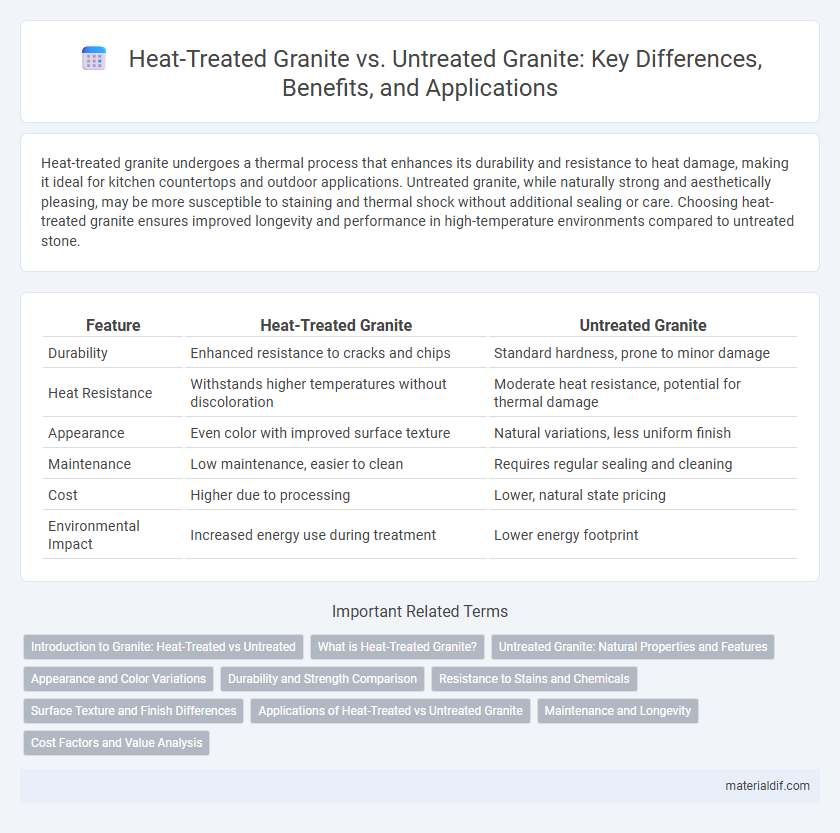Heat-treated granite undergoes a thermal process that enhances its durability and resistance to heat damage, making it ideal for kitchen countertops and outdoor applications. Untreated granite, while naturally strong and aesthetically pleasing, may be more susceptible to staining and thermal shock without additional sealing or care. Choosing heat-treated granite ensures improved longevity and performance in high-temperature environments compared to untreated stone.
Table of Comparison
| Feature | Heat-Treated Granite | Untreated Granite |
|---|---|---|
| Durability | Enhanced resistance to cracks and chips | Standard hardness, prone to minor damage |
| Heat Resistance | Withstands higher temperatures without discoloration | Moderate heat resistance, potential for thermal damage |
| Appearance | Even color with improved surface texture | Natural variations, less uniform finish |
| Maintenance | Low maintenance, easier to clean | Requires regular sealing and cleaning |
| Cost | Higher due to processing | Lower, natural state pricing |
| Environmental Impact | Increased energy use during treatment | Lower energy footprint |
Introduction to Granite: Heat-Treated vs Untreated
Heat-treated granite undergoes a thermal process to enhance its strength, color, and resistance to weathering compared to untreated granite. This treatment alters the mineral structure, resulting in improved durability and a more polished appearance, making it ideal for outdoor and high-traffic applications. Untreated granite retains its natural state, offering unique textures and colors but may be more susceptible to wear and environmental factors.
What is Heat-Treated Granite?
Heat-treated granite undergoes a specialized process where intense heat is applied to enhance its durability, color, and texture, making it more resistant to scratching and chipping compared to untreated granite. This thermal treatment alters the stone's crystalline structure, resulting in a harder, more resilient surface ideal for high-traffic areas and exterior applications. Untreated granite retains its natural state with original physical properties, offering a more porous and softer finish prone to wear over time.
Untreated Granite: Natural Properties and Features
Untreated granite displays its natural properties such as high durability, exceptional hardness, and inherent resistance to scratches and heat, making it ideal for countertops and flooring. Its porous surface allows for natural breathability but may require sealing to prevent staining and moisture absorption. The unique mineral composition and organic patterns of untreated granite offer a distinctive aesthetic that varies with each quarry source, emphasizing authenticity and natural beauty.
Appearance and Color Variations
Heat-treated granite exhibits a richer, more vibrant color palette with enhanced depth and contrast, creating a distinct visual appeal compared to untreated granite. Untreated granite displays more natural, often muted tones that highlight its original mineral composition without alteration. The heat treatment process intensifies color variations, resulting in a glossy, polished finish that draws out unique patterns and textures inherent in the stone.
Durability and Strength Comparison
Heat-treated granite undergoes a thermal process that enhances its durability by increasing resistance to abrasion, making it more suitable for high-traffic areas. Untreated granite, while naturally strong and dense, may be more prone to minor surface wear and chipping under heavy impact compared to heat-treated varieties. The heat treatment modifies the stone's microstructure, improving overall strength and longevity without compromising its aesthetic qualities.
Resistance to Stains and Chemicals
Heat-treated granite undergoes a controlled thermal process that enhances its resistance to stains and chemicals compared to untreated granite. This treatment reduces the porosity and strengthens the surface, making it less susceptible to absorbing liquids and resisting harsh chemical exposure. Untreated granite, while naturally durable, is more prone to staining and chemical etching without additional sealants or treatments.
Surface Texture and Finish Differences
Heat-treated granite features a rougher, more textured surface due to exposure to high temperatures that cause the stone to fracture slightly, enhancing slip resistance and creating a rugged, natural finish ideal for outdoor applications. Untreated granite retains its original smooth, polished surface with a glossy finish, highlighting the stone's natural color and grain patterns. The difference in surface texture between heat-treated and untreated granite significantly affects their aesthetic appeal and functional performance in construction and design projects.
Applications of Heat-Treated vs Untreated Granite
Heat-treated granite exhibits enhanced durability and resistance to weathering, making it ideal for outdoor applications such as building facades, monuments, and paving stones where exposure to harsh elements is common. Untreated granite, with its natural texture and color variations, is favored for indoor uses like countertops, flooring, and decorative wall cladding where environmental wear is minimal. Selecting heat-treated granite extends lifespan and maintains aesthetic integrity in high-traffic or exposed environments compared to untreated granite.
Maintenance and Longevity
Heat-treated granite features enhanced durability and resistance to staining, making it easier to maintain compared to untreated granite, which may require more frequent sealing and care to prevent damage. The heat treatment process strengthens the stone's surface, extending its longevity by reducing the likelihood of chips and cracks. Untreated granite, while still robust, tends to show wear sooner and demands consistent upkeep to preserve its natural beauty over time.
Cost Factors and Value Analysis
Heat-treated granite undergoes a specialized thermal process that enhances its durability and resistance to weathering, resulting in a higher price point compared to untreated granite. The cost factors include increased production expenses due to energy consumption and technology, which justify the premium through extended lifespan and improved aesthetic appeal. Value analysis reveals that while untreated granite offers a more budget-friendly option, heat-treated granite provides superior long-term investment potential for outdoor applications.
Heat-Treated Granite vs Untreated Granite Infographic

 materialdif.com
materialdif.com